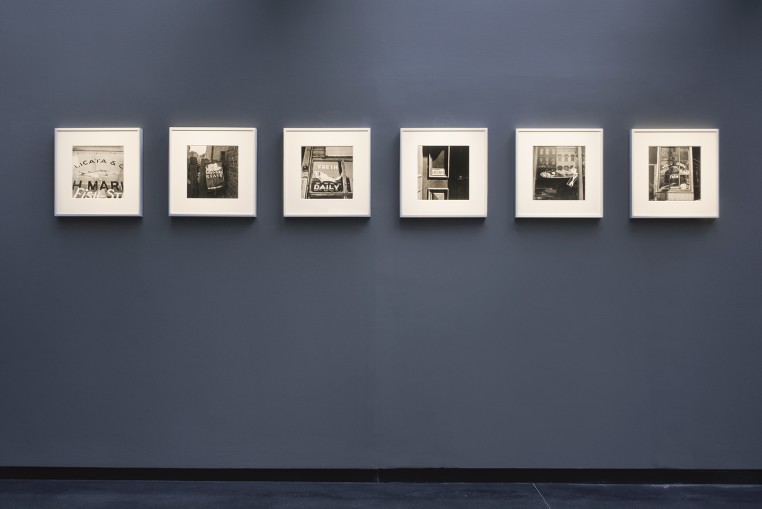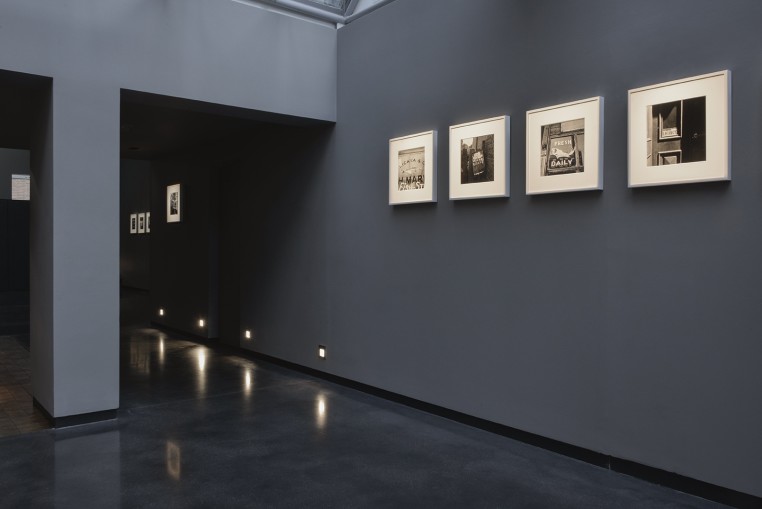Ever since antiquity, signs have served as messengers for the promotion of a business’s wares or services. These physical traces of human activity have become imbued with a range of cultural connotations and associations throughout the course of civilisation’s evolution. Whether drawn on the storefronts of Pompeii, carved out of wood and hung over shop entrances in Edo Japan, painted on panels and displayed in windows in Europe or America, or created and displayed in myriad other ways, these manifestations of commerce are a touchstone of quotidian activity.
In some of his earliest forays with a camera, Irving Penn took careful notice of these signs. He saw personal expressions of a merchant’s hope for more business, a preacher’s wish for a congregation, some way to catch the eyes of passers-by. The variety and combination of words and symbols, expressed typographically or manually, could have appealed to the young Penn as a form of commercial ‘portraiture’, each a reflection of its owner-creator. Penn’s photographs of signs in this exhibition, captured in the late 1930s and early 1940s in New York and the American South, show his early interest in stepping outside the studio, something Penn would explore further later in his career.
As a commercial graphic artist at the beginning of his career, Andy Warhol was charged with creating imagery that would convey the desirability of the products on offer to the consumer audience. He took these early experiences to heart, and his innovative appropriation of the language of advertising became a hallmark of his post-modern inventions. His stitched photographs and silkscreens present viewers with a new way of interrogating this aspect of commercial activity.
Presented together for the first time ever, Hamiltons’ exhibited Irving Penn’s and Andy Warhol’s perspectives on this cultural phenomenon, side by side.
Irving Penn, widely recognised as one of the world’s most important photographers, is celebrated for his innovative commercial imagery and pioneering editorial contributions to Condé Nast publications. In addition to these professional assignments, Penn also pursued a range of personal projects throughout his long career, such as nudes, self-portraits and signage, as seen in this exhibition. Penn’s extensive oeuvre of work explores the boundaries of personal and public expression, and consequently art and commerce, through captivating images that expanded the creative limits of photography. Penn’s technical mastery of both black-and-white and colour photography, as well as the platinum printing process, earned him accolades in the realms of both commercial and fine art. Penn does not rely on the familiar, instead venturing into the unknown by challenging the technical limits of photography and expectations of what can, and does, comprise a memorable image. Penn’s aesthetic is the result of his readiness to push his work to the verge of what people find acceptable and the strength of his pictures lies in their power to re-orient our sensibilities.
The Metropolitan Museum of Art presented Irving Penn: Centennial in early 2017; the exhibition then travelled to C/O Berlin in Germany, the Grand Palais in Paris and is currently at the Instituto Moreira Salles in Sao Paulo, Brazil. Within this exhibition, Penn’s signs are explored, including examples of early work in New York, the American South, and Mexico. The show opens with early works from the 1930s, a series of note like photographs of storefronts, hanging signs and shadows in the urban landscape. They reveal Penn’s interest in documenting American reality, beautiful or not – a perspective also highlighted in his slightly later photographs of the American South, and seen in this exhibition.
Andy Warhol, a leading figure in the visual art movement known as pop art, worked in the 1960s – 1980s. His work is known for exploring the relationship between artistic expression, celebrity culture and advertising. During the mid 1980s, when the U.S.A. was still in the midst of the Cold War, Andy Warhol returned to the newspaper adverts that had informed his paintings in the early 1960s and the start of his career. Warhol began to screen print advertisements on canvas – a group of works called ‘Ads and Illustrations’, a small selection of which are seen in this exhibition. His stitched photographs also took a turn towards the vernacular subjects of the cityscape, two of which are featured in the exhibition.
By presenting Irving Penn’s and Andy Warhol’s ‘Signs’ together, visual and aesthetic correspondences emerged, creating a dialogue between them. This leads viewers to perceive the connections - and the chasm - between the classically ‘modern’ and the stark ‘post-modern’. There is more to this dialogue than meets the eye - it’s a place to begin to link these two great artists’ contributions to the canon of art.


